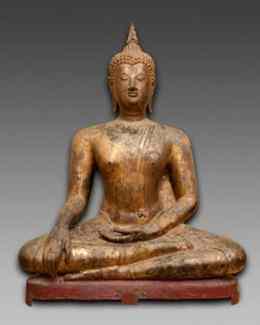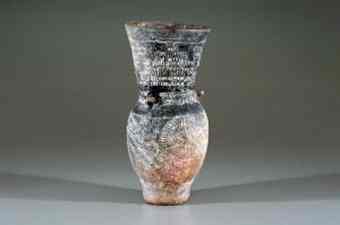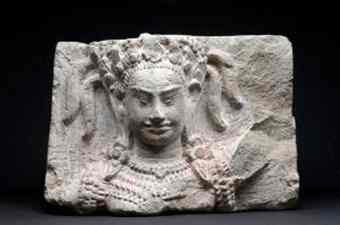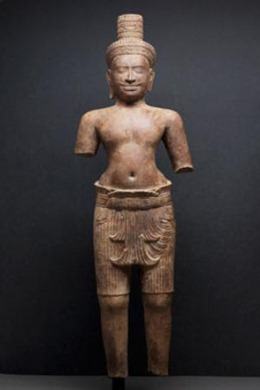When considering the Honolulu Academy of Arts' Asian collection, most folks would think of ukiyo-e first, then Chinese and other Japanese art, says Asian art curator Shawn Eichman.
 The museum's current show, "Four Thousand Years of Southeast Asian Art," could alter that. As with other exhibits in the past couple of years, this one features a collection from Academy vaults — and what treasure troves the Southeast Asian repositories have turned out to be.
The museum's current show, "Four Thousand Years of Southeast Asian Art," could alter that. As with other exhibits in the past couple of years, this one features a collection from Academy vaults — and what treasure troves the Southeast Asian repositories have turned out to be.
Eichman aimed to view the entire collection of 1,700 pieces, but several months and almost 700 works later, "three areas of strength started to emerge," he says.
"The selection and organization came from the collection itself. As I went through the collection, it really spoke of its own strengths."
The first was works from the Ban Chiang culture, the Bronze Age of Thailand, featuring bronze and ceramic pieces from as far back as 5,000 years ago. Pieces from the era constitute the first of three sections in the exhibit.
 The discovery of the culture itself is directly tied to University of Hawaii archaeologist Wilhelm Sondheim, who unearthed Ban Chiang artifacts in 1966 while performing excavations. "It made quite a splash," says Eichman.
The discovery of the culture itself is directly tied to University of Hawaii archaeologist Wilhelm Sondheim, who unearthed Ban Chiang artifacts in 1966 while performing excavations. "It made quite a splash," says Eichman.
"Until Sondheim's (findings), even specialists of the area tended to look at Southeast Asia as a transitional, secondary zone between China and India. The area was called Indochina and had to take its name from two cultures on either side of it," he said.
"Sondheim's discovery was the first evidence of an independent culture in Southeast Asia. It shook the idea of Indochina."
Another strength of the academy's collection comes from the Angkor Kingdom (802-1432), situated in parts of modern-day Cambodia and Thailand. This second section of the show features large and miniature stone and bronze sculptures depicting Buddhist and Hindu figures and mythical creatures, plus an exploration of Angkorian ceramic traditions.
 Some of the academy's collection from the Sukhothai Kingdom (13th to 15th century) make up the third segment of the show. Sukhothai artists created intricate bronze depictions of the Buddha, but the era is best known for its vibrant ceramics industry that competed with China in Indonesia and the Philippines.
Some of the academy's collection from the Sukhothai Kingdom (13th to 15th century) make up the third segment of the show. Sukhothai artists created intricate bronze depictions of the Buddha, but the era is best known for its vibrant ceramics industry that competed with China in Indonesia and the Philippines.
Eichman says the museum's collection parallels Hawaii's key role in Southeast Asian studies. The academy bought its first Southeast Asian piece more than 80 years ago; today, it is one of only a handful of U.S. museums with an extensive collection.
"Nationally, the academy certainly has one of the top 10 collections. It has strong Thai and Cambodian collections in particular," says UH's Paul Lavy, assistant professor of South and Southeast Asian art history.
Lavy assisted Eichman with the written aspects of the exhibit and gave lectures at the academy last month.
 The exhibit features 150 pieces and took 18 months to put together. Because the collection is so extensive, Eichman says he could have concentrated on a later era and still produced an equally good show. "We have a fantastic collection of textiles," he says.
The exhibit features 150 pieces and took 18 months to put together. Because the collection is so extensive, Eichman says he could have concentrated on a later era and still produced an equally good show. "We have a fantastic collection of textiles," he says.
With this show joining a lineup of impressive exhibits generated from Academy vaults, Eichman says the museum's curators are finding that "in many cases, exhibits from our own collection are just as good or better than those we bring in from other places."
In fact, some Academy shows have traveled and been big hits abroad. "Hiroshige: Master of Nature," which ran from March to September last year, traveled to Rome and was "wildly successful."
"This was the first exhibit in Rome dedicated to one Japanese artist," he says. "It was extended three months and sometimes had a thousand visitors a day. For these people, it was a lifetime opportunity.
"In addition to local pride for what we have here, there's an international pride as well over how well a collection does abroad."
Author: Joleen Oshiro | Source: Star Advertiser [November 21, 2010]